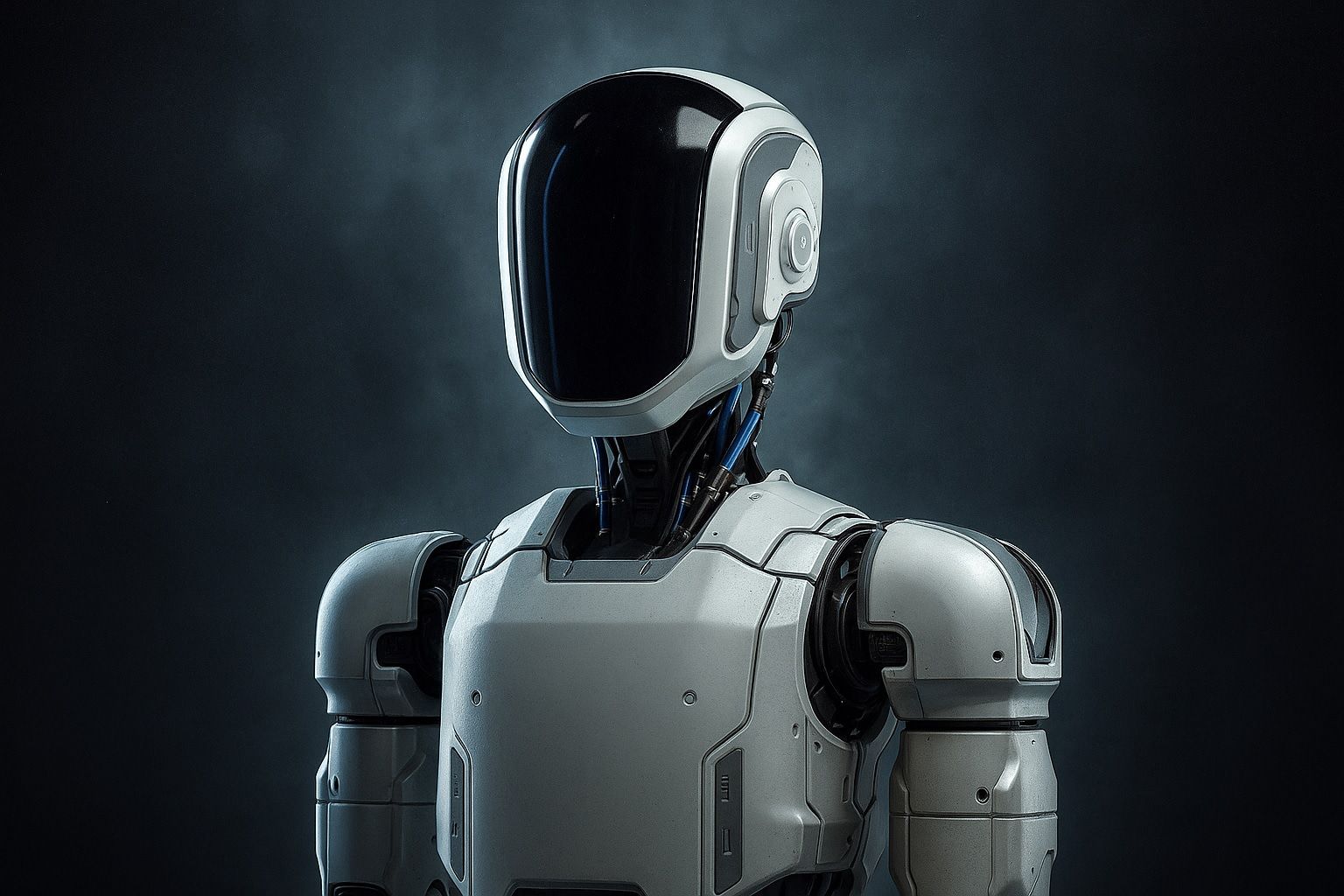Russia’s much‑publicised AI humanoid robot, AIDOL, stumbled and fell during its first public appearance on a Moscow stage, turning a triumphant tech showcase into a viral lesson on the limits of current robotics – and the pressure on Russia’s sanctioned tech sector to prove itself.
- AIDOL, billed by state media as Russia’s first anthropomorphic robot with artificial intelligence, collapsed face‑first seconds after stepping onto a Moscow stage on 11 November. [1]
- The robot walked out to the Rocky movie theme, tried to wave, lost balance and was hurriedly dragged away while staff tried to hide the mishap behind a black curtain – all captured on video. [2]
- Developers say the fall was likely caused by lighting and voltage fluctuations and framed it as “real‑time learning” rather than a failure. [3]
- AIDOL is part of a Kremlin‑aligned push to build mostly domestic AI and robotics hardware as Western sanctions restrict access to advanced components; the robot reportedly uses around three‑quarters Russian‑made parts. [4]
- The incident comes as global rivals like Tesla’s Optimus, Figure 03 and Chinese Unitree humanoids race ahead, in a market analysts say could be worth $4–5 trillion by 2050. [5]
A debut choreographed for glory – and for memes
On Tuesday, 11 November, a black‑and‑silver humanoid robot waddled onto the stage at a Moscow technology showcase, flanked by two handlers and backed by “Gonna Fly Now” from Rocky. State and local media had trailed the event as the unveiling of one of Russia’s first AI‑powered humanoid robots, meant to symbolise the country’s technological resilience under sanctions. [6]
Instead, the star attraction, named AIDOL (often stylised “Aidol”), managed only a few unsteady steps. As it raised its right arm to wave, the robot lurched, staggered and then went down face‑first onto the stage. Video shows the handlers scrambling to drag the fallen machine away while other staff attempt to pull a large black curtain across the stage to hide the scene from journalists and guests. [7]
Clips of the fall spread rapidly across X, TikTok, YouTube and Telegram, amplified by Western and Russian‑language outlets alike. The Washington Post, Reuters, AP, the BBC and others ran the footage or stills, while tech aggregators such as Techmeme promoted headlines about “Russia’s much‑hyped humanoid robot face‑planting onstage.” [8]
What was meant to be a tightly scripted demonstration of Russian AI prowess had, within hours, become a global meme.
What is AIDOL – and what was it supposed to prove?
According to the robot’s developer and Russian media reports, AIDOL is designed as a general‑purpose humanoid able to walk on two legs, manipulate objects with its hands and hold basic conversations with people – the three “key human functions” its creators emphasise. [9]
From publicly available specifications:
- Height: about 1.86 m (6 ft 1 in)
- Weight: roughly 95 kg (209 lb)
- Top walking speed: around 6 km/h (3.7 mph)
- Payload: can carry roughly 10 kg (22 lb)
- Face & expressions: 19 actuators enabling at least 12 recognisable emotions and “hundreds” of micro‑expressions
- Battery & autonomy: claimed to work offline for up to six hours without a network connection [10]
Developers say all core systems — movement, perception and speech — can run locally, a point repeatedly stressed in Russian reporting as evidence that AIDOL does not rely on Western cloud services. [11]
The robot is produced by a company also called AIDOL, registered in August 2025 and positioned as the flagship project of the New Technological Coalition, a consortium of robotics firms and technical universities. Coalition head Alexey Yuzhakov has said he hopes to raise up to $50 million (about 4 billion rubles) from domestic and foreign investors to push anthropomorphic robots into service industries, logistics hubs, banks, airports and other public venues. [12]
In terms of origin, AIDOL is pitched as a mostly Russian‑made robot: the company and Russian business press say approximately 73–77% of its components are domestically sourced today, with a target of more than 90% localization at mass production. [13]
Developers blame lighting and voltage – and call it “real‑time learning”
So what went wrong on stage?
After the fall, AIDOL’s chief executive Vladimir Vitukhin suggested that the robot’s stereo cameras may have misread the environment due to poor lighting in the hall, and also mentioned possible voltage fluctuations affecting its balance systems. He insisted that the robot had previously been tested on many different surfaces – “stones, carpet, laminate, expanded clay, slippery floors” – without incident. [14]
Vitukhin also framed the mishap as part of the robot’s development: local outlets quoted him describing the incident as “real‑time learning” and saying he hoped “this mistake will turn into experience,” echoing standard language from machine‑learning research about turning errors into better models. [15]
A journalist from Meduza noted that, before the debut, Yuzhakov had warned that relatively little effort had gone into improving AIDOL’s walking compared with other capabilities – an admission that looks prescient after the fall. [16]
Later in the day, the robot reportedly returned to the stage for a second attempt, this time with stabilising support. It stayed upright, according to Moscow news agencies, and Vitukhin said AIDOL had not been damaged. [17]
Online reaction: “runs on vodka” and “Putin’s robot double”
If the technical explanations were sober, social media reaction was anything but.
The video of AIDOL’s debut drew millions of views across platforms within hours. Some users joked that the robot “runs on vodka”, echoing a headline from the Times of India that highlighted a wave of comments comparing the machine’s unsteady walk to public drunkenness. [18]
Others seized on the robot’s facial design, saying it resembled President Vladimir Putin, and shared clips under captions like “Putin’s robot double collapses on the job.” British tabloids and broadcasters amplified the “Putin lookalike” angle, framing the fall as an accidental political cartoon. [19]
Not all reactions were derisive. Some roboticists and engineers pointed out that falls are common in early humanoid prototypes, even in well‑funded Western labs, and argued that AIDOL’s spill was more about over‑confident staging than about Russian engineers being uniquely incompetent.
Still, for a project explicitly designed as a symbol of national technological prowess, the optics were disastrous.
Why humanoid robots still fall over
Strip away the geopolitics and memes, and AIDOL’s fall is a reminder of a simple truth: walking on two legs is extremely hard for machines.
Humanoid robots must constantly solve a complex physics problem: keep a tall, heavy body balanced on a tiny support area (two feet) while joints move, surfaces change and sensors stream noisy data. Small errors in perception, timing or torque can send the centre of mass beyond a recoverable point, especially when the robot is mid‑step or mid‑gesture.
Even cutting‑edge systems that use reinforcement learning and large “world‑model” neural networks – the kind of research now standard in top labs – show that first‑attempt success on complex tasks can be as low as 20–30%, improving only after many cycles of trial, error and adjustment. [20]
In other words, what Vitukhin calls “real‑time learning” is not entirely spin. Modern humanoids do get better from repeated failures. The question is where those failures happen:
- In controlled lab environments, with safety harnesses,
- or in front of the national and international press, to a triumphant soundtrack.
Russia’s long quest for a humanoid – from FEDOR to AIDOL
AIDOL is not Russia’s first attempt at a humanoid body.
In the 2010s, Russian engineers built FEDOR (Skybot F‑850), a teleoperated humanoid originally conceived for rescue missions. FEDOR gained international attention in 2019 when it was sent to the International Space Station, posting quips on social media about building robot colonies in space before the project was retired. [21]
Earlier still, St. Petersburg engineers unveiled ARNE and ARNEA, a male and female pair of androids capable of walking, recognising objects and responding to voice commands.
What makes AIDOL different is the claim – repeated by Russian state news agency TASS and others – that it is the country’s first anthropomorphic robot with on‑board artificial intelligence, designed to operate autonomously for hours rather than strictly as a remote‑controlled avatar. [22]
That difference matters politically: it ties AIDOL directly into Moscow’s broader narrative that Russia can build its own AI stack, from algorithms to hardware.
AI and “technological sovereignty” under sanctions
Since 2019, the Kremlin has treated artificial intelligence and robotics as strategic priorities, codified in its National AI Strategy and updated technology roadmaps. These documents explicitly link AI investment to national security and “technological sovereignty” – the ability to operate without relying on foreign suppliers. [23]
Western sanctions imposed after the 2022 invasion of Ukraine, and tightened repeatedly since, have restricted Russia’s access to advanced semiconductors, automation equipment and dual‑use electronics. Washington and Brussels now routinely target Russian and Chinese intermediaries involved in supplying chips, robotics components and industrial control systems. [24]
That pressure has pushed Moscow toward aggressive import‑substitution programs and a rapid expansion of domestic robotics and electronics production. Analysts note that Russia’s industrial robotics market has reoriented toward Asian suppliers and home‑grown solutions, even as quality and scale lag behind global leaders. [25]
In this context, AIDOL’s touted 70‑plus percent domestic component share – with an ambition to reach more than 90% – is a political message as much as a technical spec: a humanoid meant to say, “We can do this ourselves.” [26]
The irony is that the robot’s very public tumble risks reinforcing another narrative: that catching up under sanctions will be slow, messy and prone to highly visible setbacks.
How AIDOL compares to Tesla, Figure and Unitree
Globally, AIDOL is arriving in a crowded and fast‑moving humanoid race.
- Tesla Optimus: Tesla’s prototype humanoid stands around 1.7 m tall and weighs roughly 55–60 kg, with a payload of about 20 kg. Elon Musk has repeatedly said he expects Optimus to become “more valuable than the car business” as a general‑purpose factory and service robot. [27]
- Figure 03 (Figure AI): California‑based Figure introduced its third‑generation Figure 03 in October 2025, designed from the ground up to learn directly from humans through a system called Helix. The company pitches it as a safe, general‑purpose worker for homes and industry, backed by major Silicon Valley investors. [28]
- Chinese humanoids – Unitree & others: China’s Unitree G1 and newer R1 humanoids have gone viral for videos showing robots running, cartwheeling and even mock sparring, with the R1 priced at under $6,000 – a headline‑grabbing figure even as experts debate how representative the demos are of real‑world performance. [29]
On the market side, Morgan Stanley and other analysts estimate that humanoid robots could represent a $4–5 trillion annual market by 2050, with perhaps hundreds of millions to a billion units deployed globally. Adoption is expected to be slow in the 2020s, accelerating sharply in the 2030s and 2040s as costs fall and capabilities improve. [30]
Within that landscape, AIDOL is taller and heavier than many rivals and, on paper, roughly comparable in carrying capacity and speed. But the real differentiator is not raw specs; it is:
- Software maturity (how robust is its perception and control stack?),
- Manufacturing scalability, and
- Reliability in uncontrolled environments – the exact area where its debut went wrong.
Beyond the face‑plant: how serious is this setback?
In robotics terms, one stage fall is embarrassing but not fatal.
Humanoid projects in Japan, the U.S., South Korea and China have all suffered high‑profile stumbles during demonstrations. Boston Dynamics’ earlier Atlas models famously tripped during DARPA challenges; other humanoids have fallen down stairs, misplaced steps or misjudged slopes during live events.
What makes AIDOL’s case distinctive is the political staging:
- A national capital,
- a triumphant soundtrack,
- state media branding it a first‑of‑its‑kind achievement, and
- a domestic component story aimed squarely at sanctions skeptics.
That framing magnified a technical glitch into a geopolitical meme.
From here, several questions will determine whether AIDOL becomes a footnote or a serious player:
- Technical transparency – Will developers publish more details about the control system, walking algorithms and safety mechanisms, or will the robot remain a closed, PR‑driven project?
- Iteration pace – Can the New Technological Coalition show convincing progress over the next 12–24 months, with stable, repeatable demos outside tightly controlled stages? [31]
- Real deployments – Do we see AIDOL prototypes piloted in factories, warehouses, banks or public spaces, even in limited roles, or does the project stall at the prototype and exhibition phase?
- Funding vs. reality – Will investors buy the narrative that a mostly domestic Russian humanoid can compete with Tesla, Figure, Unitree and others already field‑testing robots in real‑world environments?
What this moment says about AI in 2025
AIDOL’s fall in Moscow has resonated far beyond Russia because it captures a wider tension in the AI boom of 2025:
- On screen, AI appears almost omnipotent, from image and code generation to eerily human chatbots.
- In hardware, even walking across a stage without falling remains an unsolved problem at scale.
The viral clip of a highly hyped humanoid robot eating the stage to the Rocky theme is funny. It is also a reminder that bringing AI out of the cloud and into the physical world is a slow, bruising process – for robots and reputations alike.
If AIDOL’s creators live up to their own rhetoric about “learning from consequences,” the real story of Russia’s first AI humanoid robot will not be the moment it hit the floor, but whether it can get back up and walk convincingly into version two.
References
1. www.washingtonpost.com, 2. www.washingtonpost.com, 3. www.washingtonpost.com, 4. www.washingtonpost.com, 5. en.wikipedia.org, 6. www.washingtonpost.com, 7. www.washingtonpost.com, 8. www.washingtonpost.com, 9. www.washingtonpost.com, 10. www.washingtonpost.com, 11. meduza.io, 12. www.washingtonpost.com, 13. www.washingtonpost.com, 14. www.washingtonpost.com, 15. meduza.io, 16. meduza.io, 17. meduza.io, 18. timesofindia.indiatimes.com, 19. www.thetimes.com, 20. arxiv.org, 21. en.wikipedia.org, 22. www.washingtonpost.com, 23. xpert.digital, 24. home.treasury.gov, 25. globaltribune.net, 26. www.washingtonpost.com, 27. en.wikipedia.org, 28. www.figure.ai, 29. www.unitree.com, 30. www.morganstanley.com, 31. www.washingtonpost.com









